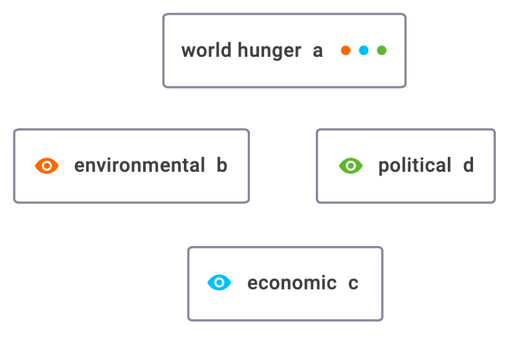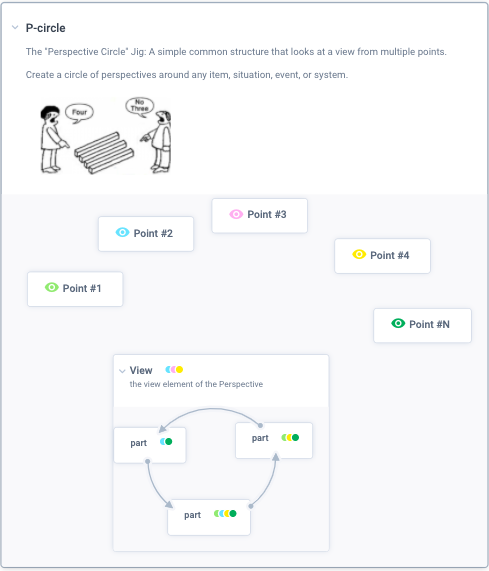Jig: P-Circle
 Derek & Laura Cabrera
·
4 minute read
Derek & Laura Cabrera
·
4 minute read
Excerpt from the book: Systems Thinking Made Simple, Chapter 5
This blog is part of a set of blogs under the"cognitive jigs."Be sure to check out the tag to read them as a group and learn how cognitive jigs are at play in our everyday lives.
Remember that perspectives in Plectica are shown by an eye-ball on the top right corner of any square. This means that an idea or thing is “viewing” some other thing or idea. Figure 5.7 reads, “an idea (b) from the perspective of idea (a).” Remember also that a perspective is comprised of a point (here, b) and a view (here, a).

Figure 5.7: Perspective Diagram With Point and View
Changing the point or the view changes the perspective. Most of our thinking errors come from thinking that the point is the same as the perspective when it’s not. A perspective is made up of both a point and a view. So, while there are only two things in Figure 5.8 (Dad and Me), they can be configured into four different perspectives depending on which thing occupies which position (point or view) of the perspective. C and D show dad's perspective on himself and my perspective on myself. In these cases, the point and the view are the same (i.e., self-reflection).

Figure 5.8: Four Perspectives
If we are to escape the category cul de sac but still benefit from its use we should replace static categories with part-whole systems grouped dynamically by perspectives.
Figure 5.9 illustrates how combining a view with multiple points can create multiple perspectives in a cognitive jig we call "Perspective Circles" or P-Circles. The idea is that there is some thing or idea that is the view and we take a look at that thing or idea from multiple points simultaneously.
We represent taking multiple perspectives by adding eyeballs on each point and also distinguishing between them (i.e., different cards). The P-Circle in Figure 5.9 reads, “an idea (a) viewed from point (b) and point (c).” A simple example would be looking at a new product (a) from the point of view of marketing (b) and engineering (c).

Figure 5.9: P-Circle with 2 Perspectives
Figure 5.10 shows another P-Circle which reads, "world hunger from three points of view: environmental, economic, and political." Because these cognitive jigs are content-agnostic, we could add any content of the form, “idea (a) from three different points of view: (b)(c) and (d).”

Figure 5.10: 3 Points of View on World Hunger

Figure 5.11: 3 Examples of a Perspective Circle, Where One Thing is Viewed from 3 Points of View
Note in Figure 5.11 that the same P-circle structure can be used and reused in many topical areas. The Plectica map shows a simple P-circle with three points on a single view. Because jigs are content agnostic, the same P-circle structure can be used across 3 wide-ranging examples, where the perspectives are distinguished by their color (1, 2, and 3). For example, in the #1 example racism is seen from the perspective of a person of color, not a person of color, and a biracial person.
A P-Circle is a remarkable jig with broad application. Any time we explore any idea we can take multiple perspectives on it.
Looking at something from different perspectives often yields different parts. The Plectica map in Figure 5.12 reads, “a whole idea (a) from three points of view (b)(c)(d), each yielding different parts (b1, b2, b3, c1, c2, c3, d1, d2, d3).” For example, a wicked problem, the AIDS epidemic, requires taking multiple perspectives to make headway on a solution.
When we look at the AIDS epidemic (a) from the perspectives of epidemiology (b), government policy (c), and socio-cultural factors (d), you'll see many sub-issues that must be considered to reduce the worldwide incidence of AIDS. These sub-issues are brought to light by the different perspectives. For example, when looking at the AIDS epidemic (a) from the perspective of epidemiology (b) we know that we must attend to control of the infection (b1), patterns of spread (b2), and patient monitoring and tracking (b3). The government policy perspective (c) highlights the need for coordination among the Center for Disease Control (c1), World Health Organization (c2), and tribal governments (c3). Factors that need to be considered from a socio-cultural perspective include sexual practices (d1), group stigma (d2), and religious norms (d3).

Figure 5.12: Parts of the View Seen from 3 Different Points (AIDS Epidemic)
Note in Figure 5.13 that the jig’s basic structure is content agnostic. Three different content areas utilize the same basic structure.

Figure 5.13: 3 Examples of Parts of the View Seen from 3 Different Points
Sub-Perspectives
It’s important to note that the point of a perspective is not always homogeneous. In Figures 5.12 and 5.13 the points cause the view to have parts that are uniquely associated with a given point. In contrast, Figure 5.14 illustrates that the point can also be a whole made up of parts. Te point (a) and the view (b) can contain any level of complexity. For example, if you are developing a new solution to a wicked problem like world hunger (b), then obviously figuring out a solution requires looking at the problem from many different perspectives (a), each of which might have subparts.

Figure 5.14: Points are Wholes With Parts
As another example, Figure 5.15 shows that we might think about the Muslim perspective on the War in Afghanistan.

Figure 5.15: Homogeneous Perspective

Figure 5.16: Heterogeneous Perspective
Thinking systemically in Figure 5.16, however, allows us to see that there is not a singular Muslim perspective on the war, but rather a number of sub-perspectives such as radical, conservative, and moderate Muslims, and in reality many more. The map in 5.16 shows this combination of perspective and part-whole systems. Solutions to messy problems require finer-grain analysis, including breaking the point of the perspective down into parts.
In Figure 5.17, we can see a single jig’s basic structure remains the same but can be used across 5 different topical areas.


Figure 5.17: Agnostic Structure of Jigs
Root Perspectives
Perspectives aren't only from things that have eyes. An idea can be a perspective. For those things for which it is at first difficult to think of as the point of a perspective, think of them as a lens through which you are looking at another thing. For example, we can take a concept as a perspective like “war from the perspective of evolution.” Every thought, claim, argument, fact, and idea has a perspective. But often the perspective is hidden: sometimes on purpose, sometimes not. We call these root perspectives. For example, most maps are representations of the world from the perspective of land mass (Figure 5.18).

Figure 5.18: Root Perspective of Land Mass
But take a different perspective and you get a very different-looking map. Figure 5.19 shows the world from the perspective of total population.

Figure 5.19: Root Perspective of Total Population
More distressing, take a look (Figure 5.20) from the perspective of the incidence of yellow fever:

Figure 5.20: Root Perspective of Yellow Fever
As we saw with category cul de sacs, there is always a root perspective, even if it has not been made explicit. Developing a mindset that always looks for and finds root perspectives is foundational to critical and independent analysis.
Want to play with some interactive resources? Check out these Jig Maps:
.png?width=150&height=150&name=CRL%20GOAT%20Logo%20(4).png)




